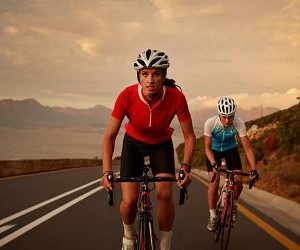Master endurance cycling in tropical climates with effective strategies. Learn hydration, heat adaptation, and training tips for peak performance.
HOW DO I INCREASE FLEXIBILITY FOR CYCLING PERFORMANCE?
Cycling may seem like a sport of pure strength and endurance, but flexibility is equally important for maximizing efficiency and preventing injuries. Tight muscles restrict your range of motion, reduce pedaling power, and increase discomfort on long rides. By integrating targeted stretching, mobility exercises, and recovery techniques, cyclists can optimize posture, improve biomechanics, and sustain higher performance levels. This guide explores why flexibility matters, which muscle groups need the most attention, and practical routines to unlock your body’s potential on and off the bike.

Why flexibility matters in cycling
Flexibility is often overlooked in cycling because the sport emphasizes endurance and power output. However, being flexible directly impacts your efficiency and ability to generate sustainable force. The cycling position — bent at the hips, rounded through the shoulders, and locked into repetitive pedaling — places unique demands on your body. Without sufficient flexibility, cyclists risk muscle imbalances, limited mobility, and discomfort during long rides.
Flexibility allows you to maintain an aerodynamic yet sustainable position on the bike. For example, supple hamstrings and hip flexors enable a lower torso angle without straining the lower back. Similarly, flexible shoulders and spine reduce tension when reaching for the handlebars, especially in aggressive racing stances.
Key benefits of flexibility for cyclists
Enhanced pedaling efficiency through greater hip and knee mobility.
Reduced risk of overuse injuries in the lower back, hips, and knees.
Improved comfort, especially on endurance rides lasting several hours.
Better posture on and off the bike, preventing chronic stiffness.
Flexibility is not about being able to touch your toes or perform yoga-level splits; it’s about functional range of motion that supports your cycling mechanics. A body that moves freely allows you to harness power efficiently while reducing wasted energy in compensatory movements.
Ultimately, cyclists who prioritize flexibility are rewarded with smoother pedaling, improved endurance, and a reduced likelihood of nagging injuries that can derail training plans.
Effective stretches for cyclists
Cyclists should target the muscle groups most stressed by repetitive pedaling: hamstrings, quadriceps, hip flexors, glutes, calves, and the lower back. Stretching these areas not only restores balance but also prepares the body for sustained effort on the bike.
A combination of static and dynamic stretches works best. Dynamic stretches — performed before rides — prime the muscles for movement, while static stretches — held after riding — encourage long-term flexibility and recovery.
Recommended cycling stretches
Hamstring stretch: Sit on the floor with one leg extended, reaching toward your toes to release tight hamstrings.
Hip flexor lunge: Step into a deep lunge with the back knee on the ground to open up tight hips from cycling posture.
Glute stretch: Cross one ankle over the opposite knee while lying on your back and gently pull toward your chest.
Calf stretch: Place hands on a wall and extend one leg back, keeping the heel down to lengthen the calf.
Spinal twist: Sit cross-legged, place one hand behind you, and twist the torso to relieve lower back tension.
Incorporating a 10–15 minute stretching routine after rides accelerates recovery by reducing muscle tightness and improving circulation. Over time, consistency yields noticeable improvements in comfort, particularly when holding aero positions on long climbs or time trials.
It’s also valuable to integrate yoga-inspired movements such as downward dog or pigeon pose. These compound stretches target multiple muscle groups simultaneously, saving time while addressing the interconnected nature of cycling tightness.
Stretching may not deliver instant performance gains like interval training, but it builds the foundation for sustainable progress. A flexible cyclist can train harder, recover faster, and enjoy more efficient biomechanics on every ride.
Mobility and recovery strategies
Flexibility goes hand in hand with mobility and recovery. While stretching lengthens muscles, mobility drills improve joint function and dynamic range of motion. Recovery practices then help maintain these gains by reducing stiffness and inflammation.
Foam rolling is one of the most effective tools for cyclists. Rolling the quadriceps, IT band, hamstrings, and calves promotes blood flow and eases knots that limit flexibility. Similarly, massage guns or manual therapy can target deeper muscle tissues. These techniques enhance recovery after hard training sessions while preparing the body for future rides.
Mobility and recovery essentials
Foam rolling: Spend 1–2 minutes per muscle group post-ride to release tension.
Dynamic mobility: Incorporate leg swings, hip circles, and torso rotations before cycling.
Active recovery: Light rides or walks the day after hard sessions keep muscles supple.
Sleep and hydration: Essential for cellular repair and maintaining tissue elasticity.
Another overlooked factor is core strength. A stable core allows better hip movement and reduces compensatory strain on the lower back. Integrating planks, bridges, and rotational exercises supports both flexibility and performance.
Cyclists should also respect periodization. Just as training has cycles of intensity and rest, flexibility and mobility require progression. Begin with shorter routines and gradually extend duration or intensity. Overstretching too soon can cause strain, while steady, consistent effort builds lasting gains.
Ultimately, recovery practices are as important as the training itself. By combining stretching, mobility, and recovery, cyclists protect their bodies, enhance performance, and ensure longevity in the sport.
Flexibility is not a bonus for cyclists; it is a necessity. When paired with smart recovery, it transforms the way the body adapts to training stress, helping riders pedal stronger, longer, and with greater enjoyment.
YOU MAY ALSO BE INTERESTED






